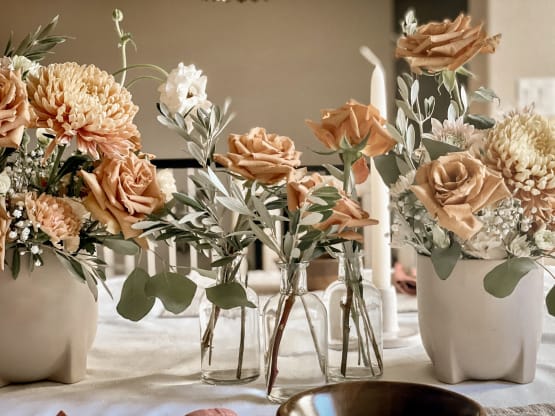The Origin of Flowers As Part of the Thanksgiving Table
Written By Amity Moore Joyce
Like the turkey served at Thanksgiving, we often take the floral centerpieces that adorn the table for granted. Not for granted in the sense that they don’t matter, but in the sense that they’re a natural part of the celebration. They’ve just always been there—next to the cranberry sauce, the stuffing, the mashed potatoes. But have they really?
At Middlemist, we wondered if the first Thanksgiving between the Pilgrims and the Wampanoag showcased bouquets? Did the women adorn the table with more than food? When did flowers become part of the Thanksgiving table?
According to Malka Benjamin, associate director for historic sites & guest experience at Plimoth Patuxet Museums in Plymouth, Massachusetts, “the only primary source description we have of the event now known as the "First Thanksgiving" says nothing about decorations on the table or anywhere else.”
The source also doesn’t reveal what the women were doing before or during the celebration. Benjamin, however, adds, “We know that the few women who survived the first winter shouldered the burden of cooking and doing laundry for many of the other single men in the town throughout 1621. Based on this fact, and our knowledge of women's roles generally in the period, Plimoth Patuxet historians feel confident in saying that the female colonists likely shouldered a large portion, if not all, of the cooking and food preparations for the celebratory feast now known as the "First Thanksgiving."
So, maybe there were some flowers. Or, maybe the women were so busy cooking the goose, duck, turkey and deer that the men had harvested that they didn’t have time to think about the pretty extras.
Thanksgiving didn’t become the holiday, as we know it, until the mid-19th century. An article in “Smithsonian” magazine explains that at the time a letter describing the first Thanksgiving written by Edward Winslow, an English leader who had attended the harvest feast, had been printed in a pamphlet called “Mourt’s Relation,” and a manuscript “Of Plimoth Plantation” by Governor William Bradford, also in attendance, had been rediscovered and published.
The article’s author Megan Gambino writes, “Boston clergyman Alexander Young printed Winslow’s letter in his ‘Chronicles of the Pilgrim Fathers,’ and in the footnotes to the resurrected letter, he somewhat arbitrarily declared the feast the first Thanksgiving…There was nostalgia for colonial times, and by the 1850s, most states and territories were celebrating Thanksgiving.”
Even then, little was documented about the adornments of the Thanksgiving table. Benjamin asserts, “the decoration of the table changed as ideas about proper table setting evolved. It wasn't something that is mentioned at any length in the early descriptions of feasts because it was just assumed that a housewife would want to use her most fashionable tableware.”
She adds, “In the earliest fictional description of a New England thanksgiving, published in the novel “Northwood” in 1827, Sarah Josepha Hale writes, among lengthy descriptions of the food:
‘The table, covered with a damask cloth, vieing [sic] in whiteness, and nearly equaling in texture, the finest imported, though spun, woven and bleached by Mrs. Romilly's own hand, was now intended for the whole household, every child having a seat on this occasion…’
Benjamin points out that later, major cookbooks, in addition to recipes and tips, included images of Thanksgiving decor. On page 597, The Boston-Cooking School Cookbook (Fannie Farmer) from 1917, for example, shows a Thanksgiving arrangement. Check out pages 592 and 596 to see examples of other floral centerpieces, some of them quite elaborate, that likely were deemed appropriate for Thanksgiving.
Now, as celebrants did then, we take our cues from current trends, styles, and personal taste. And while we don’t have a hard date for when the look of the holiday table took on nearly as much importance as the food served and the gratitude expressed, we accept that Thanksgiving floral arrangements are an inherent, welcome part of the beautiful bounty.
To see some of the unique floral holiday arrangements designed by Golden florist Middlemist and available for delivery or as part of a flower subscription, visit middlemist.co.


